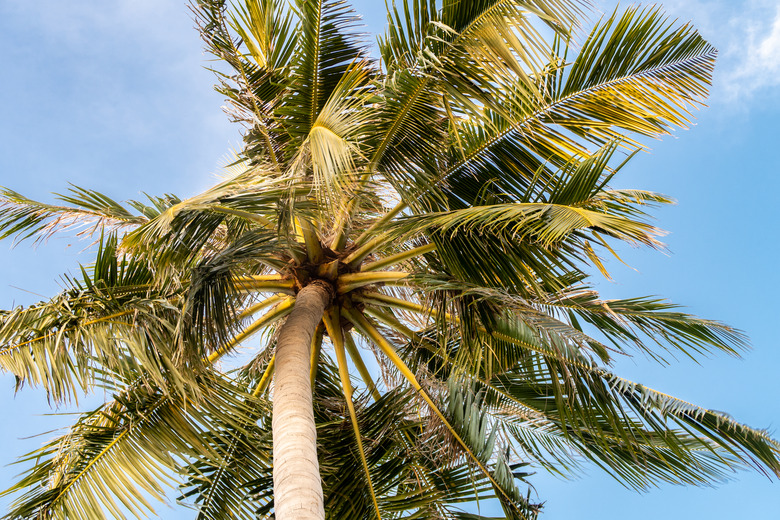How To Cure Palm Tree Fungus
We may receive a commission on purchases made from links.
While bacterial infections aren't usually a problem for palms (Arecaceae), palm tree fungus is often the cause of diseases in these tropical trees, which come in a variety of types and can sometimes produce fruit. If you notice your palm tree start to decline, there's a good chance there's a palm tree fungus to blame. The progression of the diseases and the symptoms your tree displays can help you determine the specific cause of the issues. Many palm tree fungal diseases kill the palm tree, and the focus becomes preventing it from spreading to other palm trees.
Ganoderma Butt Rot
Ganoderma Butt Rot
Ganoderma zonatum is the fungus responsible for causing Ganoderma butt rot in palm trees. It primarily causes rotting in the bottom 4 or 5 feet of the trunk, but the outer trunk tissues don't rot, so the trunk seems hard and solid. Inside, however, the trunk is damaged, and it will likely sound hollow if you tap on the trunk. You might notice growths or dark brown spots on the trunk.
Since the trunk still feels hard, you might notice other symptoms first, including older fronds that droop and wither, falling parallel to the palm trunk. When new growth appears, it's often stunted or has a pale color. Eventually, the trunk can collapse. The palm tree often dies within three to four years.
There's no way to control this disease once it infects a palm tree. The fungus can survive in old plant tissues and in the soil. Always get rid of old palm materials to prevent spreading the disease to new palms. Never plant a palm in the same spot where a previous palm had the fungal disease. You can also protect your palm by being careful not to injure it, which makes it more susceptible to this disease and other fungal diseases.
Bud Rot Palm Tree Fungus
Bud Rot Palm Tree Fungus
A number of palm tree fungus culprits are to blame for bud rot, and it can also have bacterial causes. Bud rot is most likely to happen when you're getting excessive rain or right after a tropical storm. Cold weather can cause bacterial bud rot. Palm trees usually don't recover from bud rot, which slowly kills all of the fronds, leaving only the trunk behind.
The symptoms start in the buds and young fronds, with black lesions covering those areas and wilting the young leaves. The buds rot, and you might notice the affected areas turning slimy once other diseases or pests take advantage of the damage. As the disease progresses, the older fronds start to die. This can take several months.
Since there aren't any treatments, the best option is to remove and destroy the infected palm tree to keep it from spreading. You can help prevent bud rot by watering your palm trees at the base instead of using overhead irrigation. Fungicides containing copper might help prevent bud rot from developing if a palm tree was exposed to the disease. Continue applying the fungicide as new tissues develop.
Fusarium Wilt on Palm Trees
Fusarium Wilt on Palm Trees
Fusarium wilt typically happens when the fungus Fusarium oxysporum is spread to a palm tree through pruning equipment. There's no treatment for this disease, which affects queen palms (Syagrus romanzoffiana, USDA zones 10-11), Canary Island date palms (Phoenix canariensis, zones 9-11) and Mexican fan palms (Washingtonia robusta, zones 9-11). This palm tree fungus interferes with the tree's ability to transport water through the plant. Symptoms start on the lower fronds, working their way upward. Leaves begin to yellow and die until all of the leaves and the growing tip are dead.
If you have a tree with fusarium wilt, don't plant another palm tree in that same spot since the fungus can live in the soil. When pruning your palm trees, always sanitize the pruning equipment using household bleach or rubbing alcohol to prevent spreading the fungus.
Leaf Spots and Leaf Blights
Leaf Spots and Leaf Blights
These palm tree fungal diseases first show themselves as small, water-soaked spots, gradually increasing in size and spreading as the disease develops. They turn yellow, gray, brown or black and often have an outer ring that's a different color. The spores are often spread by wind and water as well as poorly sanitized pruning equipment.
Prune diseased parts of the palm as soon as you notice them and destroy the debris. Fungicides might help prevent the disease from spreading, but they're generally ineffective in curing the disease. Avoid watering the palm from overhead, as keeping the leaves wet can contribute to leaf spot and leaf blight. Always sanitize pruning equipment to keep the disease from spreading.
References
- University of Florida IFAS Extension: Leaf Spots and Leaf Blights of Palm
- University of California Agriculture and Natural Resources: Diseases of Palm Trees: Some New Some Old
- Clemson Cooperative Extension: Palm Diseases & Nutritional Problems
- University of Florida IFAS Extension: Ganoderma Butt Rot of Palms
- University of Florida IFAS Extension: Fusarium Wilt of Palm Trees
